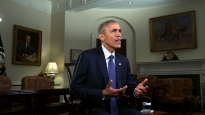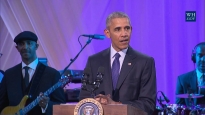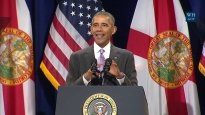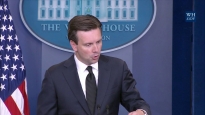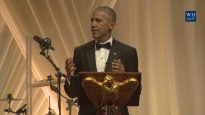President Obama and President Clinton Speak on Better Building Initiative Investments
December 02, 2011 | 17:37 | Public Domain
President Obama and former President Bill Clinton announce a $4 billion investment in energy efficiency upgrades for commercial buildings.
Remarks by President Obama and Former President Clinton on We Can't Wait: Better Buildings Initiative
Transwestern Building
Washington, D.C.
11:28 A.M. EST
PRESIDENT CLINTON: Well, I never got to open for The Rolling Stones, so I’ll try to do my best for the President.
Thank you all for being here, and I want to thank all the people involved in the tour that we just received for their commitment to energy efficiency and all the people they put to work.
Mr. President, I want to thank you and Secretary Chu and Gene Sperling and your whole team. Tom Donohue and Randi Weingarten, thank you for joining together today for what you are doing.
When the President asked me to work with his Jobs Council on improving energy efficiency in buildings, I think he did it because the Clinton Global Initiative and my own climate change project have been working on these kinds of things for several years now, and I believe as strongly as I can say that this is good business, creates jobs, makes us more energy independent and helps to fight climate change. It’s the nearest thing we’ve got to a free lunch in a tough economy, because all of the savings can be paid back within a reasonable amount of time -- I mean, all the costs of the construction -- through lower utility bills.
So we’ve been working on that. And the President has an announcement to make about that today.
I just want to say how grateful I am to Rich Trumka and the AFL-CIO and to Randi Weingarten for the work that labor has done in putting up some of the pension funds from California and some other funds they have to actually invest their own money gambling that they can get a reasonable return and putting people to work. And I appreciate the support that Tom has given to this, because there are a lot of construction firms that are going to lose really skilled, gifted workers if they can’t find something to do, because there’s not a big demand for new buildings today and therefore the best opportunity to preserve and rebuild this sector is through greater energy efficiency.
I want to thank all the people who have been involved in this. And Mr. President, I just want to say how grateful I am for the meeting we just attended. The President’s Jobs Council and economic team put together a meeting that we were just present at -- there were nearly 50 people there. And he’ll tell you what they said they would do. But -- I hate to sound like a broken record -- we could create an almost unlimited number of jobs out of this, even in this lousy economy, even with all this embedded mortgage crisis, if we can work out the financing.
And I am grateful to be able to support this, to offer the continued effort of our climate change project and the Clinton Global Initiative to help the partners we have that are involved in this and anybody else that wants it. But I’m especially grateful that the President didn’t let this fall through the cracks.
You know that I haven’t been in that job for a long time, and I’m getting older, but I have some memory left. And a thousand people ask you to do a thousand things. And one of the tests of whether things work out or not, since you can’t do all thousand, is whether you can actually set up a process to do things and follow up. And I am full of gratitude and praise, Mr. President, for you and your whole team, not just for your commitment to green energy, but for your commitment to energy efficiency, which gives you -- on buildings like this, averages 7,000 jobs for every billion dollars invested -- by far the greatest bang for the buck of any available investment I know.
So, thank you, Tom. Thank you, Ricky -- Randi. And Mr. President, thanks for giving me a chance to work on this.
Thank you.
PRESIDENT OBAMA: Well, good morning, everybody. I want to first of all thank Randi and Tom for their participation. And I am thrilled that President Clinton has been willing to take this on. As he pointed out, partly thanks to me, he’s home alone too often. And this has been a passion for him for quite some time. So I am very grateful for his involvement.
I thank everybody at Transwestern and all the folks who are participating here for giving us this remarkable tour.
There are the equivalent of 250 full-time workers as a consequence of the project that’s taking place here. It is a win for the business owners; it is a win for the tenants of this building; it is a win for the construction workers who are participating and for the property manager that’s doing such a great job. So this is a great example of what’s possible.
As President, my most pressing challenge is doing everything I can every single day to get this economy growing faster and create more jobs. This morning we learned that our economy added another 140,000 private sector jobs in November. The unemployment rate went down. And despite some strong headwinds this year, the American economy has now created in the private sector jobs for the past 21 months in a row; that’s nearly 3 million new jobs in all, and more than half a million over the last four months.
So we need to keep that growth going. Right now, that means Congress needs to extend the payroll tax cut for working Americans for another year. Congress needs to renew unemployment insurance for Americans who are still out there pounding the pavement and looking for work. Failure to take either of these steps would be a significant blow to our economy. It would take money out of the pocket of Americans who are most likely to spend it, and it would harm small businesses that depend on the spending. It would be a bad idea.
I think it’s worth noting, by the way, I noticed that some folks on the other side have been quoting President Clinton about it’s a bad idea to raise taxes during tough economic times. That’s precisely why I’ve sought to extend the payroll tax this year and next year. It doesn’t mean that we lock in tax cuts for the wealthiest Americans -- I don’t think President Clinton has been on board for that -- for perpetuity. But just thought that might be worth mentioning.
That’s why it’s so disappointing last night, by the way, that Senate Republicans voted to block that payroll tax cut. That effectively would raise taxes on nearly 160 million hardworking Americans because they didn’t want to ask a few hundred thousand of the wealthiest Americans to pay their fair share and get the economy growing faster than everybody. And I think that’s unacceptable.
We’re going to keep pushing Congress to make this happen. Now is not the time to slam the brakes on the recovery. Right now, it’s time to step on the gas. We need to get this done. And I expect that it’s going to get done before Congress leaves. Otherwise, Congress may not be leaving, and we can all spend Christmas here together.
Now, our longer-term challenge is rebuilding an economy where hard work is valued and responsibility is rewarded, and the middle class and folks who are trying to get into the middle class regain some security -- an economy that’s built to compete with the rest of the world, and an economy that’s built to last.
And that’s why we are here today, in a place where, clearly, there is some building going on. President Clinton, leaders of business, leaders of labor, we’re all here to announce some new steps that are going to create good jobs rebuilding America.
This building is in the middle of a retrofitting project to make it more energy efficient. Already, this retrofit is saving this building $200,000 a year on its energy bills. And as I mentioned earlier, by the time it’s finished, it will have created more than 250 full-time jobs in construction here in this building. Consider President Clinton is coming down from the New York, the fact that the owners of the Empire State Building did the same thing; they are retrofitting that iconic landmark from top to bottom. It’s a big investment, but it will pay for itself by saving them $4.4 million a year in energy costs. And it’s estimated that all the retrofitting that they’re doing will pay for itself in about four and a half years.
Making our buildings more energy efficient is one of the fastest, easiest and cheapest ways for us to create jobs, save money, and cut down on harmful pollution. It is a trifecta, which is why you’ve got labor and business behind it. It could save our businesses up to $40 billion a year on their energy bills -– money better spent growing and hiring new workers. It would boost manufacturing of energy-efficient materials. And when millions of construction workers have found themselves out of work since the housing bubble burst, it will put them back to work doing the work that America needs done. So this is an idea whose time has come.
And that’s why, in February, I announced the Better Buildings Initiative. It’s an ambitious plan to improve the energy efficiency of America’s commercial buildings 20 percent by the year 2020. And I asked President Clinton and my Jobs Council to challenge the private sector, as part of the initiative, to step up, make these cost-saving investments, and prove that it works, so that other companies follow their lead.
Now, I believe that if you’re willing to put people to work making your buildings more efficient, America should provide you some incentives to do so. That’s something that would require congressional action. And we have asked Congress to work with us to move on providing more effective incentives for commercial building owners all across the country to move forward on these energy-efficient steps. But we can’t wait for Congress to act. And if they won’t act, I will.
Which is why, today, I’m directing all federal agencies -- all federal agencies -- to make at least $2 billion worth of energy-efficiency upgrades over the next two years. None of these upgrades will require taxpayer money to get them going. We’re going to use performance-based contracts that use savings on energy and utility bills to pay the contractors that do the work. And it should keep construction workers pretty busy. In fact, this is something that the Chamber of Commerce has said is critical to private sector job creation.
The private sector and community leaders are also stepping up to the plate alongside the federal government. President Clinton and the Clinton Global Initiative have been tremendous partners in rallying them to join this effort. So in June, at CGI America, we announced initial commitments of $500 million to upgrade 300 million square feet of building space; some of these projects are already underway.
The good news is, today, we can announce that we’re going even bigger. We’ve received larger commitments. We now have 60 major companies, universities, labor unions, hospitals, cities and states, and they are stepping up with nearly $2 billion in financing to upgrade an additional 1.6 billion square feet of commercial industrial space by our target year of 2020. That’s more than 500 Empire State Buildings.
I just had the chance, along with President Clinton, to meet with representatives of these 60 institutions that are involved and hear firsthand how they can put Americans back to work but also improve their bottom lines.
So you’ve got companies like Best Buy and Walgreens that are going to upgrade store lighting, which is going to save them money. You’ve got manufacturers like Alcoa that are going to make their manufacturing plants more efficient, dramatically reducing their operating costs which means they can compete more effectively all around the world.
You’ve got property management companies that are upgrading their buildings to make their real estate portfolios more attractive to businesses, and one is already upgrading 40,000 units of military housing all across the country, which will give our military families lower utility bills and a higher quality of life. And all of this will create jobs.
So over the past decade we’ve seen what happens if we don’t make investments like these. We’ve seen what happens when we don’t come together for a common purpose -- wages flatline, incomes fall, employment stalls, and we lose our competitive edge. But we’ve also seen what happens when we do what’s right. When Bill Clinton was President we didn’t shortchange investment. We didn’t say, we’re going to cut back on the things that we know are going to help us grow in the future. We didn’t make decisions that put the burden on the middle class or the poor. We lived within our means. We invested in our future. We asked everybody to pay their fair share. And you know what happened? The private sector thrived, jobs were created, the middle class grew -- its income grew -- millions rose out of poverty, we ran a surplus. We were actually on track to be able to pay off all of our debt. We were firing on all cylinders.
We can be that nation again. That’s our goal. We will be that nation again. But we’re going to have to fight for it. So there’s work to be done. There are workers, like these guys, who are ready to do it. There are businesses that are ready to step up. We’ve just got to get organized, get mobilized, and move.
And so I just want to thank everybody who’s participating here for stepping up to the plate and showing extraordinary leadership. I am confident that this is going to be one important piece of the puzzle to get the economy moving again.
Thank you very much, everybody. Thank you, guys.
Q President Clinton, any advice to your friend -- President Clinton, do you have any advice to President Obama about the economy?
PRESIDENT OBAMA: Oh, he gives me advice all the time. (Laughter.)
PRESIDENT CLINTON: I just want to -- I’ll say again, this announcement today -- the reason you should be encouraged by this, you can run the numbers and see how many jobs he announced. But this meeting we just came from, as Dick Parsons said, represented trillions of dollars in potential investment. And if the President, by doing this, can trigger pools of investment so that you have more buildings like this, keep in mind it can also change what goes on in every rural place and small town in America.
Upstate New York, which is in trouble -- every little county has got one bonded contractor. That bonded contractor can guarantee to every public school, every state, county, and local building, every little office building in Chappaqua, New York, where Hillary and I live, what the savings are going to be. They’ve got software. We have to have breakthroughs on financing. That’s really the long-term potential significance of what the President announced today; and the fact that he did something that only a President can do -- he got all these people together, and then to have the AFL-CIO and the AFT and others sort of lead the way, and saying we will put our members’ pensions into this because we can get a good return, it’s a stable return, we’ll put our current members to work and other working people to work, and get a return on the pension.
This is a big deal. That’s the significance to this. This announcement the President made today is the jobs that you can multiply 7,000 times a billion, but it’s potentially, literally 50, 70, 80 times that because of who’s involved.
PRESIDENT OBAMA: Thanks, guys.
END
11:45 A.M. EST
|
October 22, 2016
|
October 21, 2016
|
October 21, 2016
|
October 21, 2016
|
|
October 21, 2016
|
October 20, 2016
|
October 19, 2016
|
October 19, 2016
|
- &lsaquo previous
- …
- 12
- 13
- 14
- 15
- 16
- 17
- 18
- 19
- 20
- …
- next &rsaquo
